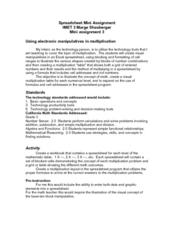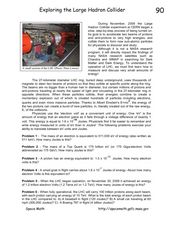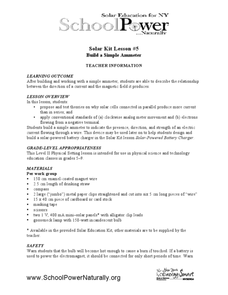Curated OER
Chemistry Worksheet (Mole)
In this chemistry worksheet, students identify and name the number of neutrons, electrons, and protons for each. Then they illustrate how the electrons are arranged in a cloud. Students also find the relative number of atoms in the two...
Curated OER
Using Electronic Manipulatives in Multiplication
Factor polynomials using electronic manipulatives. Your class will create a spreadsheet in excel and use it to multiply and perform basic operations and solve problems correctly. They create a visual to go along with each multiplication...
Curated OER
Electronic Mapping
Young scholars identify countries, oceans, and capitals by building an electronic map.
Curated OER
Chemistry: Atomic Number and Mass Number
All you will find here is a simplistic chart of 17 elements (hydrogen is repeated) for chemistry beginners to fill in. They list atomic number, mass, and the numbers of protons and electrons. There are three critical thinking questions...
Curated OER
Ions and Subatomic Particles
In this ions worksheet, students complete a graphic organizer by filling in the number of protons and electrons plus the charge of the given ion.
NOAA
Climate, Weather…What’s the Difference?: Make an Electronic Temperature Sensor
What's the best way to record temperature over a long period of time? Scholars learn about collection of weather and temperature data by building thermistors in the fourth installment of the 10-part Discover Your Changing World series....
American Chemical Society
The Periodic Table and Energy-Level Models
Teach your class to think of electrons as tiny packets of energy that travel in waves. Through a short video and diagram, participants see how electrons are located around the nucleus of an atom. They then get into groups and try to...
Curated OER
Electronic Components
Students review new terminology and computer circuits and the value of a resistor. They complete three experiments, "Resistance Activities," Transistor Activities,"Diode Activities" and enter data, results and their findings on Student...
Curated OER
Babes in Electronic Toyland
Students read a New York Times article in order to explore the use of handheld electronic devices in schools. They investigate, through surveys and essay-writing, the pros and cons of this technology.
Curated OER
The Virtual Electron Microscope
Students explore the world of the very small using a Flash plug-in Virtual Electron Microscope. They complete and discuss an activity in which unknown samples are placed under the computer simulated microscope to determine where the...
Curated OER
Cellular Respiration: Harvesting Chemical Energy
A complete overview of oxidation, reduction, and how electrons are moved in respiration. You could use this slide show to elaborate on the concept of harvesting stored energy, and to summarize the stages of aerobic and anaerobic metabolism.
Curated OER
Exploring the Large Hadron Collider
On this physics handout, pupils read about the Hadron Collider used to make new sub-atomic particles by accelerating protons. They solve 6 math problems that include translating electron volts to Joules. This is geared toward high school...
Curated OER
Transforming Energy
Super detailed, this lesson will educate physical science learners about the flow of electrons. Begin by reviewing potential and kinetic energy with a moving pendulum, and then get them online to observe interactive websites about...
Curated OER
Solar Kit Lesson #5 - Build a Simple Ammeter
Emerging electricians build a simple ammeter for making measurements on an electric current. They test the placement of solar cells in both series and parallel circuits and examine the magnetic field produced by the movement of electrons...
Teach Engineering
May the Magnetic Force Be with You
Class members use mathematics in order to better understand magnetic forces and their interaction on charged particles. After a demonstration of the interaction between a magnet and an electron beam using a CRT computer monitor,...
Concord Consortium
Understanding Probability Maps
What's the likelihood of your class understanding probability maps? Young scientists explore the concept using a virtual dartboard in an interesting simulation. The darts establish a pattern around the bull's-eye, which provides a visual...
Curated OER
Atomic Musical Chairs
An engaging activity enlightens young chemists in this lesson on atomic structure. They play musical chairs through a series of concentric circles that represent electon orbitals. A laundry basket in the middle holds the protons and...
Curated OER
Review of Ionic and Covalent Compounds and Transitioning from Ionic to Covalent Compounds
Here is a unique assigment: compare and contrast ionic and covalent compounds in an extensive data table and then analyze Lewis dot structures in antoher. Three columns are to befilled in: "characteristic or feature," "applies to ionic...
Curated OER
Science Puzzlers, Twisters, and Teasers: Chemical Bonding
What a cute approach to chemical bonding! Atoms all have human names and are attending at a dance. Who will pair up with whom? By reading the characteristics, and not the element name, chemistry whizzes figure out the bonding pairs....
Curated OER
How Cells Harvest Energy
Survey the metabolism process from respiration through the production of the ATP molecule with this seven page AP biology learning exercise. Pupils write short answers on the lines provided and label a diagram of the cellular respiration...
PhET
Molecule Shapes
The shape of a molecule is determined by the arrangement of atoms around the central atom and lone pairs of electrons. Scholars build models of molecules using single, double, and triple bonds. They can then see real molecules bond...
Concord Consortium
Polarization
This is one cool resource for teaching about polarity! Chemistry scholars observe electron distribution and molecular shape as they select different non-metals and form bonds. The interactive offers two views, surface charge and electron...
Creative Chemistry
Electron Configurations of Transition Metal Elements
For this instructional activity about elements, students review the electron configuration of given elements and then complete the electron diagrams for the transition metal elements. This instructional activity has five problems to solve.
Curated OER
The Electron Microscope
In this microscope worksheet, students read about how the electron microscope was created and how it works. Based on the reading, students complete 2 short answer questions.
Other popular searches
- Electronic Communication
- Electronics Engineering
- Electronic Bonds
- Electronic Card Catalog
- Electronic Probes
- Electronic Publishing
- Electronic Mail
- Electronic Presentation
- Electronic Messages
- Electronic Tax Filing
- Electronic Surveillance
- Consumer Electronics























